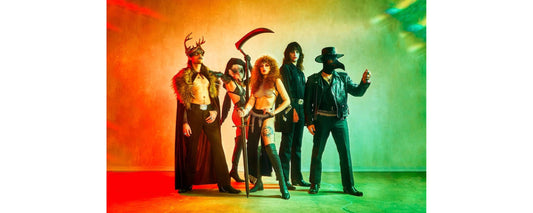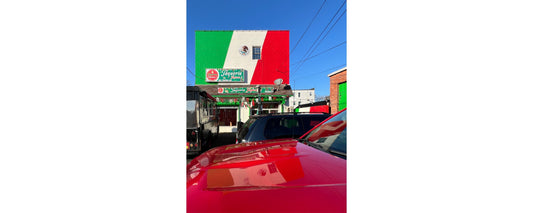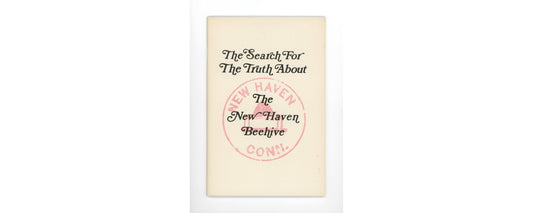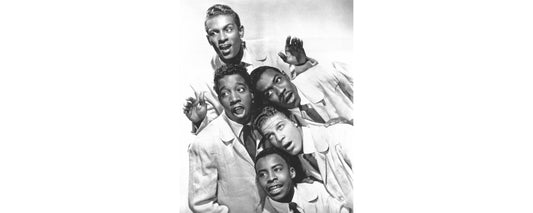George Corsillo speaks softly and carries a big stylus.
Kickstarting his “forty-something” years in graphic design, Corsillo’s “first real job” was a doozy: working in New York for Paul Bacon, “one of the most famous book jacket designers of the 20th century.” Voice suffused with awe, he points out that Bacon “did the original covers for Jaws, Catch-22, Shogun, Ragtime;” also Slaughterhouse-Five, Rosemary’s Baby and One Flew Over the Cuckoo’s Nest, plus Joseph Heller’s We Bombed in New Haven. He invented “the big-book look,” Corsillo says, marked by “little illustration and big type. I was just the mechanical person, but I learned from him how to design book jackets.”
Explaining the term “mechanical,” Susan McCaslin—Corsillo’s wife and fellow principal in Westville-based studio Design Monsters, who also worked in mechanicals at the time—says that “before computers, you would have type set by a type house, and then you would cut it out and glue it down into position on a board.” In his work, Corsillo would take “a lot of Polaroids” to send off to “stat houses,” which would reproduce and resize them as requested. So, instead of virtual layers using a program like Photoshop, with fonts and effects and copy/paste and undo/redo a keystroke or click away, a designer would use actual, material layers, plus a squad of specialized helpers, to design something like a book jacket.
Or, as the case may be, an album cover. After meeting as art students at Pratt Institute in Brooklyn, and after working in New York for a while, Corsillo and McCaslin moved to Los Angeles in the mid-70s, where they would spend several years. Corsillo got a job at Gribbitt!, “a big design studio that did all record business stuff,” he says, working for labels like RCA, Columbia, Capitol, Motown. “I was an assistant, but then the first album cover I did on my own was for the soundtrack for the movie Grease. After all these years and all the sort of famous or impressive graphic design work I’ve done, people go crazy for that.” For her part, McCaslin says she was “getting freelance jobs in the movie industry,” assisting art directors, working on props and scouting locations. “It was a real California job,” Corsillo chimes in, beaming.
sponsored by
It was out west, in that Golden State, that the couple had their first child, and, expecting two more (twins), they moved back to New York, where George opened a “little satellite studio” under the Gribbitt! banner, joking that it was a “write-off” for the company. Within a year of returning to NYC, in 1981, “I quit that and went out on my own,” under a new banner: George Corsillo Design. Meanwhile, McCaslin had begun what would turn into a 12-year ride as a stay-at-home mom.
With three children to raise, and to live less expensively, the family left the big city for Darien, CT, with Corsillo commuting back and forth. It was then that “I hit my stride,” he says, and made a movement-level mark on American culture. Still designing album covers, major book publishers approached and asked him, “‘Can you do something that looks like rock and roll?’ And I said, ‘Yeah, that’s what I do.’” He and a small group of other top, like-minded designers had been ushering the music industry’s visuals through the broader cultural transition from punk to new wave—“Punk was too rough, too black and white. We started adding color to punk, and it became new wave.”
Corsillo’s literary contributions graced books like Andy Warhol and Pat Hackett’s Popism: The Warhol Sixties (1980) and then-unknown author Bret Easton Ellis’s Less Than Zero, published in 1985 with splatters and neon green text splashed across the cover. That same year he designed a radically different cover for Larry McMurtry’s Pulitzer-winning western epic Lonesome Dove, innovating the use of a single contiguous image that wrapped from front cover to back.
Opportunity went the other way, from literature to music, as well: working for McMurtry connected Corsillo with famous small-towner John Mellencamp, who would enlist Corsillo to design 13 album covers over the next 25 years, and to art-direct some of his music videos. Corsillo would also develop a close working relationship, lasting to this day, with Doonesbury creator Garry Trudeau, coloring Doonesbury’s Sunday comic strips and working on loads of related special projects, from books to posters to figurines.
“And I was home raising the kids,” McCaslin notes without irony or resentment. “It was great.” She found time to reengage her fine arts background (at Pratt, she majored in painting), showing at several galleries between 1985 and 1990, including one in New Haven’s Erector Square. Then, as personal computers were starting to become more powerful, “I was just getting ready to go back to work,” she says. To get up to speed on computers, she would “go into a Xerox store” and learn on the models they had there; she then taught her husband how to use them. Computer proficiency freed up Corsillo to move his practice into their Darien home, where he could now do his work remotely, freeing up McCaslin to take on full-time work again. She eventually landed at Reed Exhibitions, a large trade show company based in Norwalk, for a decade, which she valued in part because it meant health insurance for the family.
sponsored by
Along the way, Corsillo’s studio took on a partner, a new name (Design Monsters) and satellite work serving a bunch of high-profile clients: Pepsi, Mastercard, Snapple. Those heavy hitters’ marketing agencies would call Design Monsters “when they had either too much work or were burned out” on a particular project, issuing a simple plea: “‘We need you to Monster-ize it.’”
After an amicable parting with Corsillo’s first partner, McCaslin joined as a principal at the firm, which moved to a big studio in a Stamford industrial park. It was a 1,000-square-foot space, with windows all around and beautiful old trees to look at. But one day the trees they loved were cut down; the neighbor whose property they were on had gotten tired of cleaning the leaves off his roof. Another day, they realized they were spending almost all their time in the studio, and very little at home in Darien. Meanwhile, their friend Cindy Clair, now the executive director at the Arts Council of Greater New Haven, had moved to the Elm City and invited them to visit a few times.
They thought about moving here, then found a situation that suited them quite well: two conjoined spaces in ArLoW (“Arts Loft West”), a complex in the heart of Westville where they could work and live, and where, since 2010, they continue to do both. Corsillo has taken to doing bombastic posters promoting the Institute Library’s “Amateur Hour” series and the local PechaKucha chapter’s seasonal gatherings. Design Monsters has also done work for Atticus Bookstore Cafe, including a fantastic local map made to look like an antique cloth-bound book, and designed Yale’s Slifka Center’s logo and website.
Websites are mostly McCaslin’s domain, by the way; the couple says she does a lot of the studio’s more structure-oriented tasks, from web coding to layout work. But she’s looking to take more of a backseat moving forward, focusing even further on her fine arts work, which she’s been actively producing for the past several years. Project Space, a new one-room gallery a couple of corners from the entrance to their home/studio, just opened her latest show, New Work. She says she has a hard time talking about that new work because it’s personal to her, and because she thinks it should be personal to the viewer, without her own attitudes getting in the way.
Or perhaps it’s that when you’re a monster of design, like McCaslin or Corsillo, the art speaks for itself, and the accolades and recognitions just sort of follow along.
Design Monsters
838 Whalley Ave #12, New Haven (map)
(203) 764-2391
www.designmonsters.com
Written and photographed by Dan Mims.









